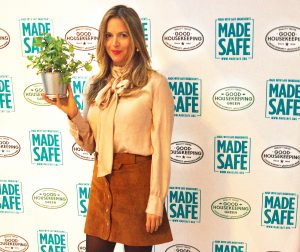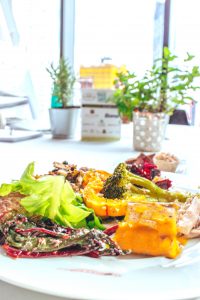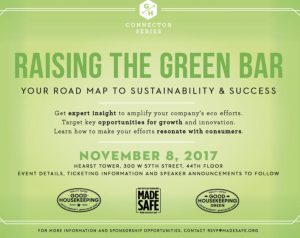It’s a quintessential fall November day and I’ve just popped out of the subway at Columbus Circle in New York City. The air is fresh, the leaves are falling, and I’m headed for the Hearst Tower for the inaugural Raising the Green Bar Summit.
 A new friend and Deputy Editor, Laurie Jennings, and her team at Good Housekeeping magazine are about to welcome the crowd for the launch of a new event, a movement really, called Raising the Green Bar. In partnership with Made Safe (a nonprofit focused on educating companies and consumers about safe ingredients in our products), Raising the Green Bar has been designed to provide a roadmap and beyond to sustainability and success for marketers, entrepreneurs, brands and consumers.
A new friend and Deputy Editor, Laurie Jennings, and her team at Good Housekeeping magazine are about to welcome the crowd for the launch of a new event, a movement really, called Raising the Green Bar. In partnership with Made Safe (a nonprofit focused on educating companies and consumers about safe ingredients in our products), Raising the Green Bar has been designed to provide a roadmap and beyond to sustainability and success for marketers, entrepreneurs, brands and consumers.
Speakers and companies such as Dr. Oz, Amanda Hearst, PHLUR, True Botanicals, S’well, West Elm, H&M, Environmental Health Sciences and more were all part of this epic day of joining forces and elevating the conversations around sustainability for a greater good.
After a delicious breakfast with Four Sigmatic Coffee (who produce a killer reishi mushroom potion), my neurons were sufficiently fired up and we were off to the races. It’s worth noting that the Hearst Tower is one of New York City’s best green spaces, and is a platinum LEED certified building. An estimated 120 attendees took their seats on the 44th floor, with a gorgeous view over Central Park. Every seat in the house was full. Tables were adorned with rosemary and mint plants, that were later offered to the guests as a take-home gift. There was no plastic in the room, and no paper pads for writing. Not only were our hosts walking the walk with this conscious choice, but you hardly noticed not having the typical conference ‘stuff’ provided to you. It was simple. And it was great.
My favorite sessions:
- Corporate Action: People, Planet & Profit – Moderator: Birnur Aral, PhD, Good Housekeeping Institute
- Cate Vanegas, Director of Marketing, Bona
- Challey Comer, SVP for the Environment, Energy + Sustainability, Capalino+Company
- Eric Korman, CEO & Founder, PHLUR
- Lisa Dreilinger, PhD, Associate Director, Reckitt Benckiser
- Jeremy Black, Co-Founder, Sambazon
- How Fashion is an Extension of Your Values Today
- Anne Fulenwider, Editor-in-Chief, Marie Claire
- Amanda Hearst, Co-Founder, Maison de Mode
- Hassan Pierre, Co-Founder, Maison de Mode
- Home & Style: The Age of Authenticity – Moderator: Kate Black, Founder, Magnifeco & EcoSessions®
- Kendra Peavy, VP, Corporate Communications at S’well
- Jennifer Gootman, VP Social Consciousness & Innovation, West Elm
- Emily Scarlett, Media Relations Manager and acting Sustainability Manager, H&M
- Disruptors: How to Move a Market – Moderator: Amy Ziff, Founder, Made Safe
- Hillary Peterson, Founder, True Botanicals
- Larry Weiss, MD, Chief Medical Officer, AO Biome/Mother Dirt
- John Matise, CEO, Eclair Naturals
- Dr. Kourosh Maddahi, Founder, Oral Essentials

There were a handful of themes that were prevalent throughout the day, in addition to a plethora of knowledge that resounded with me big time. Overall, it’s easy to slow the rate of environmental impact, but it’s much harder to stop the problem. That’s why this conversation and event was so important. Dr. Oz (a Keynote speaker) even joined us at the end of the day for wine and nibbles, to take us through his point of view: The Health Case for Making Green Choices.
Here’s the scoop on the rest of what went down:
Considerations for Brands:
- The role of retailers: retailers have HUGE powers and can transfer that to consumer to buy more responsibly. Walmart proved this with detergents by making an effort to stock less toxic products.
- Consider marketing messaging on product. Triclosan (one of the most prevalent antibacterial compounds) is found in a lot of fragrances, yet studies are investigating the potential of developing skin cancer after a long-term exposure to triclosan. PHLUR is a product that produces evocative scents that are good for your skin, and are a prime example of what a fragrance company should aspire to be. Sustainable brands should also consider fact based selling as an option, whereby products are tested against traditional counterparts to show how the makeup is different, and why that’s important.
- Create new standards when necessary: Sambazon produces açaí drinks from Brazil, but prior to Sambazon, açaí had never been certified fair trade or organic, so the company pushed for this credential. They created US awareness of the product and importance and even pioneered supply chain guidelines in the Brazillian market.
- Ingredient transparency – you as a brand push the industry forward by disclosing this information. Organic & botanical aren’t always the way to go. It’s a balance of what’s safe for humans and the environment.
- Waste in design – this concept is more important now as opposed to just sourcing organic materials. H&M is making big strides to be 100% circular in how they manufacture clothing. I had a big mis-perception of them given the fast fashion trend, and am happy to see they are being more responsible.
- Define what’s important to you through a sustainable lens. Masion de Mode defines luxury by the integrity of the product, not the price.
- Materiality assessment – align your strategy with stakeholder groups. Discover what the most important environmental and social issues are. Back up your theories with hard metrics to avoid an eco-chamber effect.
- Making green goods accessible: how can we make them more available to those who need them most? It’s no surprise that often, certain socio-economic groups are more prone to purchase. In developed nations, we are lucky to have innovations and infrastructure and the opportunity to create our own wealth. Undeveloped nations lack all of this, yet they are often the most susceptible to problematic environmental issues and poorly structured products. Brand compromise is a big issue here.
Interesting Facts:
- Baby products, ingredients & price are the factors consumers evaluate most when investigating green goods.
- Nitrosamines are carcinogenic, and condoms are full of them (yikes!). Sustain Natural helps remedy that by making condoms from the sap of rubber trees.
- The average woman uses 12 products each day – that’s 168 chemicals total daily. For men – it’s 6 products and 84 chemicals (Source: Quantis International). After these chemicals are washed off our bodies post shower, these chemicals go to a treatment plant – no bueno.
- Paper bags are actually WORSE than plastic bags! Ideally, you bring a reusable to the grocery store – this is a no-brainer for us, but if you had to pick plastic or paper, plastic is actually better (Source: Quantis International)
- 80% of environmental impact takes place during consumer use (Unilever research)
- 50 billion water bottles were used last year; we can remedy this by using reusable accessories like a S’well bottle (which are also gorgeous).
- Nature is master healer, and apple peels in specific support cellular wellness (the most sustainable fruit out there!). True Botanicals offers products, er, of this nature, to help you look better the right way. Their products are problem solvers, non toxic and certified.
Resources and Tips to Help You Live Greener:
- Own your financial structure. Step into money; you have the power as a consumer to create an ethical supply chain.
- Inward point – an agency that can help you determine your carbon footprint, and offers services such as event design, production, management, networking, and consulting
- The Green Good Housekeeping Seal is something for brands to aspire to. It accounts for water waste, transportation, CSR efforts and more, and is a real wholistic look at a product. You must receive 65/100 points to get the seal.
- Terracycle – a company that helps you package greener or recycle smarter as an individual
- Positive luxury – a company that connects you to a community of luxury lifestyle brands that share your values.
- Monterey bay seafood watch – helping consumers and businesses choose seafood that’s fished or farmed in ways that support a healthy ocean
- Back to MAC – Fans of the brand turn in six empty product packages to their local MAC counter or to the company’s website. Then, they receive a free lipstick as a thank you for recycling.
- S’well Million bottle project – pledge to help minimize consumption of plastic water bottles and other single-use plastics.
- H&M has an in-store garment-collection program where you can upcycle your old threads. Since fashion is such a resource heavy industry, H&M aims to produce all clothes from recycled materials by 2030.
 I should add that, as food is such a massive area when it comes to sustainability, our lunch was a real highlight of the day. It began with a gong ceremony led by the Urban Monk, Pedram Shojai, who is a New York Times bestselling author and producer of a new film called Prosperity. His book The Art of Stopping Time was given to attendees as a parting gift and I highly recommend it; it’s a practical way of practicing mindfulness. Heart’s Executive Chef Jason Heiselman then took the stage to warm us up by explaining every single item he had prepared for us, and where he gathered everything from (North Country flour, Acorn Hill Cheeses, Brooklyn brewery etc.) The whole meal was locally sourced, a lot coming from the Hudson Valley, and it was all sustainably prepared with an artisanal touch. The team composted all food waste during preparation, and made a zero-waste effort by even using the top of beets in a sauté, that was super tasty. And how could I forget the goats milk chocolate mouse; ridiculous.
I should add that, as food is such a massive area when it comes to sustainability, our lunch was a real highlight of the day. It began with a gong ceremony led by the Urban Monk, Pedram Shojai, who is a New York Times bestselling author and producer of a new film called Prosperity. His book The Art of Stopping Time was given to attendees as a parting gift and I highly recommend it; it’s a practical way of practicing mindfulness. Heart’s Executive Chef Jason Heiselman then took the stage to warm us up by explaining every single item he had prepared for us, and where he gathered everything from (North Country flour, Acorn Hill Cheeses, Brooklyn brewery etc.) The whole meal was locally sourced, a lot coming from the Hudson Valley, and it was all sustainably prepared with an artisanal touch. The team composted all food waste during preparation, and made a zero-waste effort by even using the top of beets in a sauté, that was super tasty. And how could I forget the goats milk chocolate mouse; ridiculous.
Raising the Green Bar was one of the most inspiring events I’ve been to in a long time, and I’ve seen my fair share of events and conferences (from over a decade of working in advertising and media worldwide). But something was different about this one. There as an overwhelming heir of optimism and positivity, and attendees shared a common goal of being a better consumer, brand, and change agent. The Made Safe and Good Housekeeping team declared November 8th ‘Global Sustainability Day’, so mark your calendars now ladies and gents – I have no doubt that Raising the Green Bar is an event you won’t want to miss in 2018.
Summary of Key Terminology and Takeaways:
- Net Positive: Transforming our business to have a restorative impact on the environment; innovating in our products and services to enable our customers to have more sustainable homes; and making a positive contribution to society and the communities in which we operate. This is often easier to achieve with agricultural products, but all should aim to reach this goal as a green, global corporate citizen.
- Green Metrics to Measure (as an individual and organization):
- Greenhouse gas
- Carbon emissions
- Carbon footprint
- Water reduction
- Waste reduction – zero waste to landfill
- Set goals & measure them!
- Triple bottom line: Social, environmental, and economic factors to consider / adhere to in order to be a sustainable organization
- Ethical fashion (an umbrella term): Fair trade, Vegan, Local / country of origin

More About Hearst:
With 20 titles in the U.S., Hearst is the largest publisher of monthly magazines with a total paid circulation of nearly 30 million (AAM 1H 2017). Hearst Magazines’ print and digital assets reach nearly 123 million readers and site visitors each month–nearly two-thirds of all women and millennial women in the country (source: 2017 comScore Multi-Platform // GfK MRI Media + Fusion (06-17/F16).
More About Good Housekeeping:
The Good Housekeeping Institute’s state-of-the-art labs combined with Good Housekeeping’s seasoned editorial talent is unparalleled. Staffed by top engineers, scientists and technology experts, the GH Institute tests and evaluates thousands of products each year for the magazine, website and for the Good Housekeeping Seal and the Green Good Housekeeping Seal, which are among the most recognized and trusted consumer icons in the world today.
More About Made Safe:
A nonprofit organization that provides America’s first comprehensive human health-focused certification for nontoxic products across store aisles, from baby to personal care to household and beyond. Their goal is to change the way products are made in this country to ultimately eliminate the use of toxic chemicals altogether. Made Safe makes it easy for people to find and buy products made without known toxic chemicals, give companies a road map for making safe products, and make it easy for retailers to select products that aren’t known to cause harm. MADE SAFE™ screens ingredients against our Toxicant Database of known harmful chemicals, which is made up of thousands of chemicals found on scientifically authoritative lists from organizations and agencies around the world.


Found in